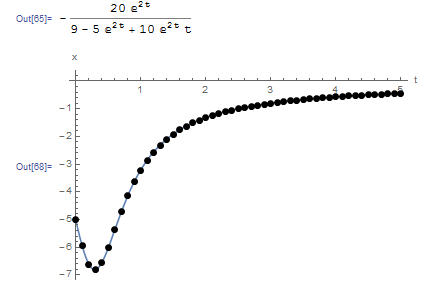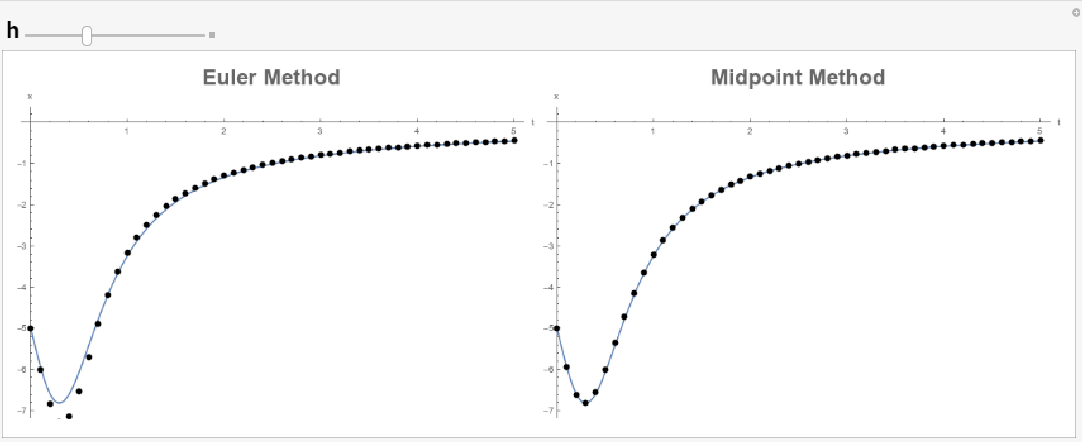Solution Methods for IVPs: The Midpoint Method
The Midpoint Method
Similar to Heun’s method, the midpoint method provides a slight modification to both the implicit and explicit Euler methods. Consider the following IVP:
![]()
Assuming that the value of the dependent variable
![]()
Therefore:
![]()
If the midpoint rule of the rectangle method of numerical integration is used for the right-hand side with one interval we obtain:
![]()
where the error term is inherited from the use of
![]()
Using this estimate, the local truncation error is thus proportional to the cube of the step size. If the errors from each interval are added together, with
![]()
which is similar to Heun’s method but better than both the implicit and explicit Euler methods. Note that the midpoint method is essentially a slight modification to the Euler’s method in which the slope used to calculate the value of
MidPointMethod[fp_, x0_, h_, t0_, tmax_] :=
(n = (tmax - t0)/h + 1;
xtable = Table[0, {i, 1, n}];
xtable[[1]] = x0;
Do[xi120 = xtable[[i - 1]] + h/2*fp[xtable[[i - 1]], t0 + (i - 2) h];
xtable[[i]] = xtable[[i - 1]] + h (fp[xi120, t0 + (i - 1-1/2) h]), {i, 2, n}];
Data = Table[{t0 + (i - 1)*h, xtable[[i]]}, {i, 1, n}];
Data)
View Python Code
def MidPointMethod(fp, x0, h, t0, tmax):
n = int((tmax - t0)/h + 1)
xtable = [0 for i in range(n)]
xtable[0] = x0
for i in range(1,n):
xi120 = xtable[i - 1] + h/2*fp(xtable[i - 1], t0 + (i - 1)*h)
xtable[i] = xtable[i - 1] + h*(fp(xi120, t0 + (i - 1/2)*h))
Data = [[t0 + i*h, xtable[i]] for i in range(n)]
return Data
Example
Solve Example 4 above using the midpoint method.
Solution
The midpoint method is implemented by first assuming an estimate for ![]() based on the explicit Euler method:
based on the explicit Euler method:
![]()
Then, the estimate for
![]()
Setting
![]()
Using this information, the slope at
![]()
Similarly, an initial estimate for
![]()
Using this information, the slope at
![]()
Proceeding iteratively gives the values of ![]() up to
up to ![]() . The Microsoft Excel file MidPoint.xlsx provides the required calculations.
. The Microsoft Excel file MidPoint.xlsx provides the required calculations.
The following graph shows the produced numerical data (black dots) overlapping the exact solution (blue line). The Mathematica code is given below.
MidPointMethod[fp_, x0_, h_, t0_, tmax_] := (n = (tmax - t0)/h + 1;
xtable = Table[0, {i, 1, n}];
xtable[[1]] = x0;
Do[xi120 = xtable[[i - 1]] + h/2*fp[xtable[[i - 1]], t0 + (i - 2) h];
xtable[[i]] = xtable[[i - 1]] + h (fp[xi120, t0 + (i - 1 - 1/2) h]), {i, 2, n}];
Data2 = Table[{t0 + (i - 1)*h, xtable[[i]]}, {i, 1, n}];
Data2)
Clear[x, xtable]
a = DSolve[{x'[t] == t*x[t]^2 + 2*x[t], x[0] == -5}, x, t];
x = x[t] /. a[[1]]
fp[x_, t_] := t*x^2 + 2*x;
Data2 = MidPointMethod[fp, -5.0, 0.1, 0, 5];
Plot[x, {t, 0, 5}, Epilog -> {PointSize[Large], Point[Data2]}, AxesOrigin -> {0, 0}, AxesLabel -> {"t", "x"}, PlotRange -> All]
Title = {"t_i", "x_i"};
Data2 = Prepend[Data2, Title];
Data2 // MatrixForm
View Python Code
# UPGRADE: need Sympy 1.2 or later, upgrade by running: "!pip install sympy --upgrade" in a code cell
# !pip install sympy --upgrade
import numpy as np
import sympy as sp
import matplotlib.pyplot as plt
sp.init_printing(use_latex=True)
def MidPointMethod(fp, x0, h, t0, tmax):
n = int((tmax - t0)/h + 1)
xtable = [0 for i in range(n)]
xtable[0] = x0
for i in range(1,n):
xi120 = xtable[i - 1] + h/2*fp(xtable[i - 1], t0 + (i - 1)*h)
xtable[i] = xtable[i - 1] + h*(fp(xi120, t0 + (i - 1/2)*h))
Data = [[t0 + i*h, xtable[i]] for i in range(n)]
return Data
x = sp.Function('x')
t = sp.symbols('t')
sol = sp.dsolve(x(t).diff(t) - t*x(t)**2 - 2*x(t), ics={x(0): -5})
display(sol)
def fp(x, t): return t*x**2 + 2*x
Data = MidPointMethod(fp, -5.0, 0.1, 0, 5)
x_val = np.arange(0,5,0.01)
plt.plot(x_val, [sol.subs(t, i).rhs for i in x_val])
plt.scatter([point[0] for point in Data],[point[1] for point in Data],c='k')
plt.xlabel("t"); plt.ylabel("x")
plt.grid(); plt.show()
print(["t_i", "x_i"],"\n",np.vstack(Data))
The following tool provides a comparison between the explicit Euler method and the midpoint method. The midpoint method behaves very similar to Heun’s method. Notice that around ![]() , the function
, the function ![]() varies highly in comparison to the rest of the domain. The biggest difference between midpoint method and the Euler method can be seen when
varies highly in comparison to the rest of the domain. The biggest difference between midpoint method and the Euler method can be seen when ![]() around this area. The midpoint method is able to trace the curve while the Euler method has higher deviations.
around this area. The midpoint method is able to trace the curve while the Euler method has higher deviations.
Lecture Video
The following lecture video covers both Heun and the Midpoint Method

